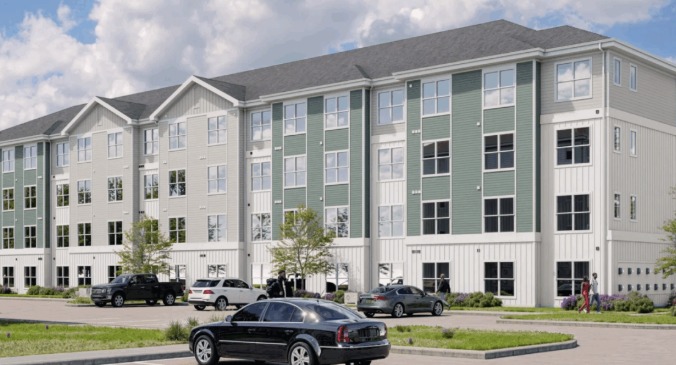Historically, when the percentage of renters leaving to buy homes is low, occupancies are healthy and so are rents. Not this time. The economic collapse and the increase in unemployment have altered that equation.
Even though the percentage of renter move-outs to home-ownership has hit all-time lows this year, the increase in the percentage of renters moving out for economic reasons has undermined any benefit the reduction in residents moving out to homes of their own might bring.
Job loss is forcing more and more renters to downsize, double up, relocate to cheaper apartments or move back home.
Camden Property Trust President Keith Oden used Las Vegas, one of the poster children for the single-family housing crisis, to illustrate his long-held opinion that what’s going on in the nation’s economy, specifically with regard to employment, is far more important in the multifamily business, than what’s going on in the single-family market.
By any standard, Las Vegas is possibly the worst market in the country for the single-family home-builder, Oden said at the beginning of the apartment REIT’s first-quarter earnings call this year.
A total of nearly 12,000 single-family homes, town homes and condos were listed for sale in the desert market as of July 29, according to the National Association of Residential Real Estate Investment Advisors. According to DataQuick, nearly 70 percent of the Las Vegas- area houses and condos that resold in July were foreclosure sales, slowing the sales of newly built homes considerably because the home builders can’t compete with discounted foreclosure resales.
The Houston-based company that was founded 27 years ago by Oden and Camden CEO Ric Campo, and became a public company in 1993, owns around 63,000 units in 180 apartment communities from coast-to- coast and 8,016 of those units are in 29 apartment communities in the Las Vegas market, where occupancies were 93 percent as of July 30.
“And yet, this quarter, we saw 8.5 percent of our residents move out to buy, and only about two percent moved out to rent a single-family home in Las Vegas,” said the president of the REIT that, at the end of Q2, owned and operated 19,509 units in 58 communities in some of the markets worst hit by unemployment and the bursting of the single- family housing bubble — Phoenix, Las Vegas, Tampa and Orlando.
“Compare where we were in Las Vegas three or four years ago at the peak of the run-up in home prices, when we were seeing 24 to 25 percent of our residents moving out to purchase a home. We went from25 percent to 8.5 percent, which is about 50 percent of our long-term average for move-outs to purchase homes in Las Vegas,” he said at the end of Q1, adding that Camden actually was seeing some benefit from the current housing mess.
“I would say further that if we woke up three to six months from now and caught lightening in a bottle and all of a sudden you saw employment tick up in Las Vegas with the kickoff and staffing of some of the new projects, you could get a very constructive result in the multifamily rental market occasioned by an increase in employment rates and still have the single-family home market in Vegas be a train wreck,” said Oden.
“I think those are related and we’ve never suggested that housing inventory doesn’t matter. It matters around the edges, but what really matters to our portfolio, because of where it’s positioned, is employment,” he said.
Camden saw an all-time bottom in the percentage of renters that moved to single-family home-ownership at 10 percent in Q1, the lowest in 17 years. That percentage ticked up slightly to 11 percent by July 30.
Adding in the two percent that moved out to rent single-family homes, it’s 13 percent against a long-term average of 18 percent, he said.
“So, we’re at historic lows in terms of home buying and I make that distinction because, in our portfolio, we’re in some of the markets that you would intuitively think would be the most susceptible to move- outs to buy homes and yet that’s just not happening,” he said.
“Which gets back to the conclusion we drew over a year ago, and have been saying ever since, that it’s not about the shadow inventory, it’s about jobs. You can explain every bit of the NOI decline in our portfolio by just looking at the employment data in Phoenix, Las Vegas, Tampa and Orlando,” he said, during a Sept. 11 panel discussion at the 2009 BMO Capital Markets North American Real Estate Conference in Chicago.
Colonial Properties Trust CEO Reynolds Thompson, another member of that BMO panel, said the highest percentage of move-outs to home-ownership was 40 percent of exiting residents in late 2005 and early 2006 for the REIT that, as of Sept. 30, owned and/or managed 36,481 apartments, 16.5 million sq. ft. of office space and 9.1 million sq. ft. of retail shopping space located in Sunbelt states from Virginia to Nevada.
“Early this year, we saw the number of people leaving to buy a home hit the lowest point that it has hit in quite some time. About 11 to 12 percent of our turnover was coming from people buying homes,” he said, adding that move-out to home-ownership ticked back up to around 15 percent by mid-September.
Some multifamily experts have speculated that the expiration of the federal government’s housing market stimulus tax credit for first-time home buyers at the end of this year, coupled with low interest rates that, in some places, have dipped below five percent, are prompting the blip in home buying enthusiasm. Thompson attributes that slight increase to prospective buyers’ perception that house values are nearing the price bottom and it’s time to buy.
AvalonBay Executive VP of Operations Leo Horey expects single-family home prices to dip a bit further in high-barrier-to-entry markets like Manhattan, Washington, D.C., San Francisco and Orange County, Calif.
“Our assumption is that prices probably still have a little ways to go down,” Horey said, predicting that home purchases will remain muted for a while because, unlike the heady subprime era, today a home buyer must have a verifiable income and money for a down payment and consumer confidence is at a very low ebb. In the company’s Q2 earnings call, AvalonBay CEO Bryce Blair noted the Commerce Board’s consumer confidence index fell to 47 in July. “A reading below 60 is generally considered to reflect recession-like pessimism and this is the 15th month the index has been below 60,” he said.
“We think home purchasing will start going back up to normal levels, but it’s hard to come up with a case where you are going to see another home buying boom again,” said Horey, who, for the past few quarters has been watching closely another emerging renter phenomenon — inter-community transfers.
In fact, moving from one apartment to another in the same community has become the most common reason for moving out of one of AvalonBay’s 50,500 mostly bi-coastal apartments, representing 16.5 percent of all move-outs at the end of Q2, down slightly from the 17.7 percent and 16.8 percent of move-outs in Q1 2009 and Q4 2008, respectively, but nearly three percent higher than the same time last year.
Anecdotal data indicates that the residents moving about within the same community are either doubling up or moving into a lower priced apartment, like a couple giving up the den in their former two-bedroom apartment for the savings on a one-bedroom unit. “What is interesting is that they are not moving out of the community. They are staying with AvalonBay,” Horey said.
As with most, if not all, of his fellow execs in the apartment REIT world, Horey is seeing record lows in the move-outs to home purchase part of the equation. “The percentage of people moving out to buy a home has gone down to 14 or 15 percent of move-outs and that was flat compared to Q1. It has been going down pretty consistently over the past six or eight quarters, when it peaked at just under 30 percent of move-outs during the home-buying boom,” he said.
The economic downturn is also showing up in the increase in move-outs due to financial issues. In Q2 of this year, financial issues accounted for 10.1 percent of move-outs at AvalonBay, compared to 11.1 percent of move-outs in Q1, 9.3 percent in the last quarter of 2008 and 9.9 percent in Q3 last year.
At apartment REIT UDR, Inc., the story is much the same. “Move-outs for home purchase continue to be very low in most of our markets.
During the quarter, only 12.6 percent of our departing residents left to purchase a home. This compares to 13.5 percent last year and 11.7 percent in Q1 ’09,” said Jerry Davis, senior VP of operations at the 37-year-old company that, as of Aug. 1 owned 44,900 apartments from coast-to-coast and had 1,916 apartments under development.
UDR saw move-out rates for home purchases of 20 percent in Phoenix, Austin, Nashville and the Inland Empire, as would be expected, given the relative affordability of homes in those markets, Davis said, adding that turnover continues to improve, with an annualized resident turnover rate for Q2 of 60.1 percent, compared to 63.4 percent in Q2 of last year, with a decrease in move-outs of five percent and significant declines in turnover in Phoenix, the Inland Empire, Metro D.C., the Mid-Atlantic and Orange County, Calif. Those markets represent less than 10 percent of UDR’s stabilized NOI.
“The highest increases in turnover have occurred in the Northern California markets, as job losses mounted in places like the Bay Area, Monterey County and Sacramento,” he told analysts during the REIT’s Q2 2009 earnings call, adding that markets with higher home prices like Orange County, San Francisco, Seattle, San Diego, Los Angeles and Metro D.C., had move-out rates for home purchase under 10 percent and contributed 45 percent of the company’s stabilized NOI at the beginning of August.
On the other side of the move-out equation, UDR also saw an increase in residents leaving for financial reasons. “Whether it’s for an eviction, a skip, a lost job or just money issues, we’ve seen that percent of reason for move-out increase over the last year. I think it was about 15 percent or so last year, and it’s north of 20 percent this year,” Davis said, lumping the bad debt in with the move-outs of those who could no longer afford the rent.
And Colonial’s Thompson also reported a big increase in the number of financially strapped residents moving out because of economic woes.
“The other factor we’ve seen change is the number of people that are leaving for job-related issues has gone up dramatically, but the last couple of months we’ve seen that fall down just a couple of percentage points,” Thompson said, noting that some of Colonial’s traffic is less qualified than those prospective renters might have been a year ago.
“More people have some financial issues and, so, may not qualify to rent,” said Thompson. AvalonBay President Timothy Naughton concurred during the REIT’s Q2 earnings call. “So far in 2009, apartment market conditions and portfolio performance have certainly felt the impact of the deteriorating job market we’ve experienced since Q4 of last year.
“In fact, any benefit in net apartment demand that we’ve seen over the last two to three years, due to declining home ownership, is now overshadowed by the bleak employment picture,” he said.
Significant household consolidation, particularly in the younger renter-oriented age group, where the unemployment rate has risen faster than in the general population, has translated into lower traffic and higher turnover in AvalonBay’s portfolio, which, in turn, has put pressure on rents, as year-over-year new move-in and renewal rates turn negative in the same store portfolio, said Naughton.
But, the future doesn’t look nearly as gloomy as the economically challenged present, he said.
“While demand is likely to stay weak for the near term, supply should continue to fall across our markets. Total net new additions to supply, after taking into account units removed from service due to obsolescence or destruction, will approach zero by the end of 2010 and be at levels not seen in decades.
“Given the capital market conditions, and projected returns on new development, new deliveries should stay in check through at least 2012, which bodes well for market conditions, once economic recovery takes hold and the job picture begins to improve,” he said, echoing the sentiments of most of his peers, that things already are beginning to look up.
















